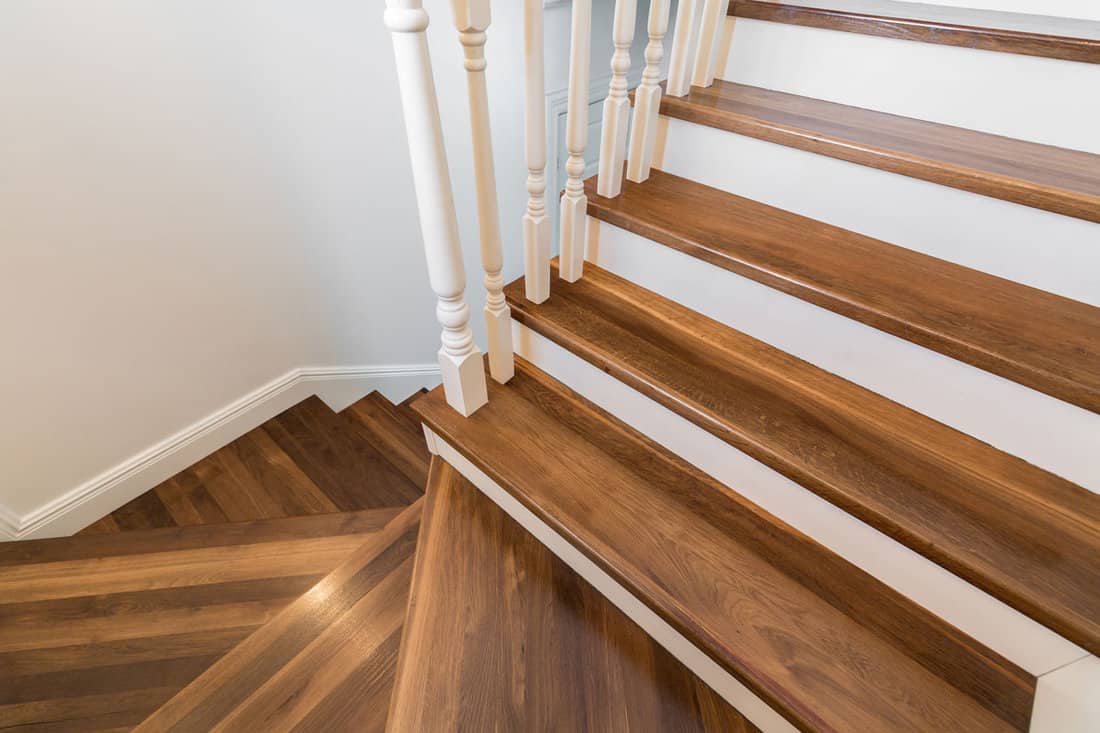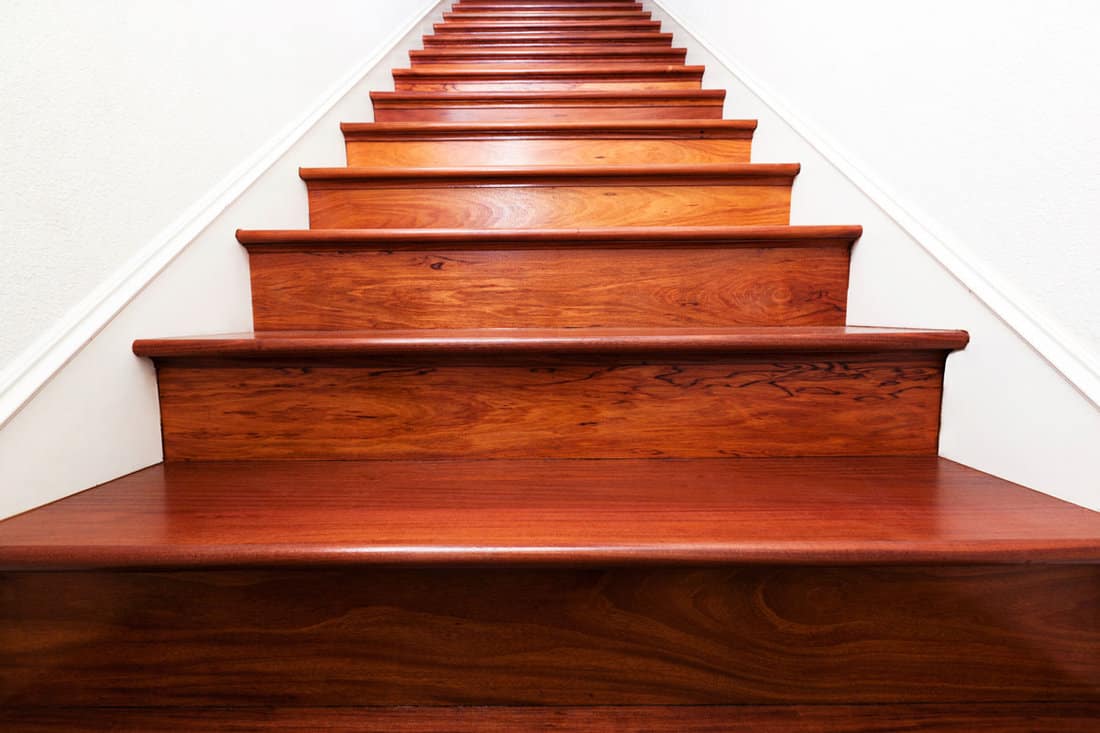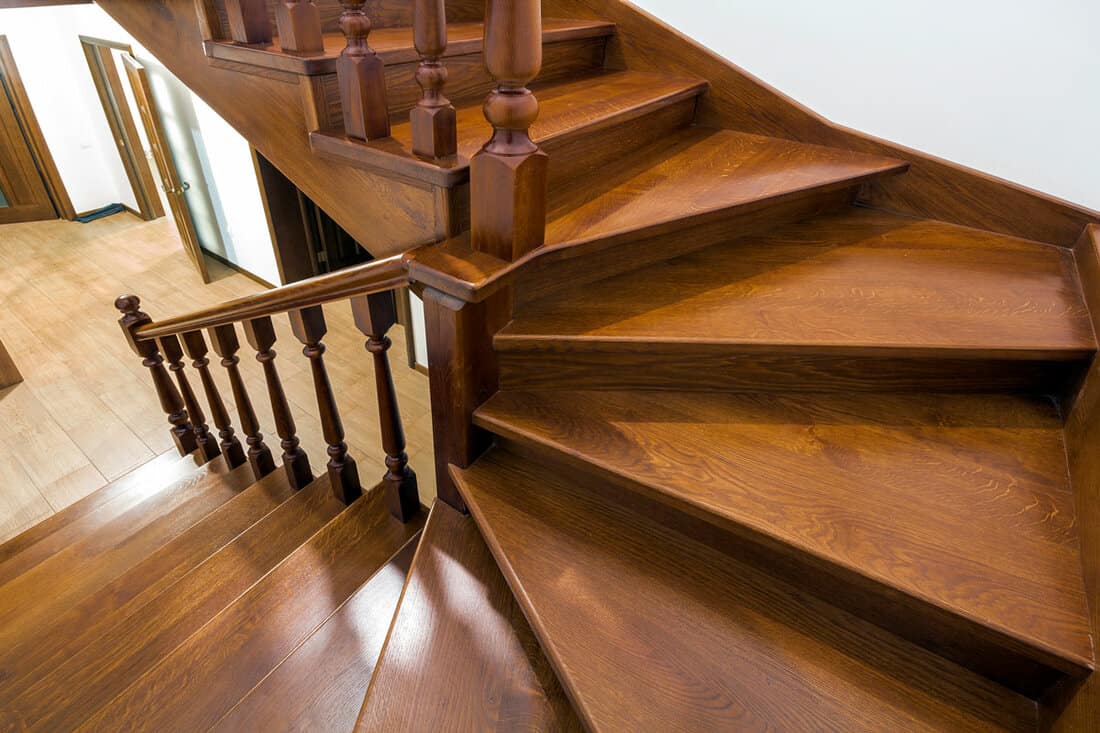- Polyurethane
- Tung oil
- Anti-skid options (finishes, paint grit additives, and spray paints)
But what is the difference between surface finish and penetrating finish? Which one should you use - and besides that, do you really need a finish at all? Keep reading for everything you'll need to know to finally wrap up your stair project, both safely and beautifully.
![Wooden staircase, What Is The Best Finish For Wood Stairs? [3 Options]](https://homedecorbliss.com/wp-content/uploads/2020/11/Wooden-staircase.png)
Best Finish For Wood Stairs
Finishes come in two major types, surface and penetrating. The surface finish creates a durable coating on top of the wood, shielding the wood from anything that might contact and damage it. Penetrating finish soaks into the wood, working to maintain the integrity of the wood itself.
1. Polyurethane (Surface Type Finish)
Polyurethane is the best surface finish for stairs. Surface finishes do have some drawbacks. The main one is that they can cover up the natural charm of wooden stairs. A penetrating finish lets the wood shine through a bit more. But in the case of stairs, they really can use the extra protection. Nothing's going to keep them safe quite as long as covering them with a hard coat of polyurethane.
We sometimes add affiliate links and content that was curated and created by our team with the help of advanced ai tools to help showcase the best design styles.

Cons of Surface Finishes
The downside to using polyurethane is that, eventually, you will need to refinish your stairs. While coating the stairs with polyurethane prevents damage to the wood, you do need to reapply a new coat of polyurethane occasionally. This means sanding down the old coat first, every time. More natural options available in penetrating finishes do not require resanding. However, these finishes also do not offer the same protection as polyurethane.
Should I put Polyurethane Over Stain?
Using a water-based modified polyurethane such as this one by Minwax is the best of all worlds to protect yet allow the stain's hue to shine through. It is low odor and easy to clean, like other water-based wood finishes. But it is also strong and can withstand the high traffic that stairs are typically exposed to. This is thanks to the modified recipe that includes oil characteristics by Minwax. Be sure to use a satin kind, as high-gloss options show scuffing too much to be a good choice for stairs.
Click here to see Minwax polyurethane on Amazon.
What Is The Difference Between Varnish and Polyurethane?
There are several kinds of surface finishes besides polyurethane. Some examples are shellac, lacquer, and varnish.
- Shellac adds a warm amber finish to wood but can be damaged or react to heat or chemicals. Shellac has a classic look that works well for historical pieces but isn't as durable as newer options.
- Varnish is most useful for exterior wood. It protects like any other surface finish but also prevents damage from UV rays.
- Lacquer creates a smooth, glossy finish. Most surface finishes go on with a paintbrush. In the case of lacquer, a sprayer is used.
2. Tung Oil (Penetrating Type Finish)

Cons of Surface Finishes

The biggest drawback to oiled stairs is that they need regular maintenance. Though you'll save time never sanding again, you will have to oil fairly often to keep them looking good. At least the task is easy - simply coat the oil on the stairs, then wipe the excess away.
How to Apply Pure Tung Oil to Wood Stairs?
3. Anti-Slip Wood Stair Finishes
Bona Traffic (Anti-Slip Formula)
Non-skid Paint Additives
Anti-slip Spray Paints
Does Stained Wood Need A Finish?

Stains are applied to wood as a decorating choice. Stains change the color and look of the wood. They help to coordinate your wood with the rest of the room.
The finish, on the other hand, is applied after the stain. It makes a durable coating that protects the wood from damage and fading. In the case of stairs (and most wood), finishing is not a required step. However, it is necessary if you want your stained wood to last and continue looking as nice.
Stairs, in particular, are a hard-wearing area in the house. Wooden stairs take a lot of abuse. To take the time and money to sand and stain your stairs, then not bother protecting them with a finish is just asking for trouble. It's a lot like buying a new car and then leaving the windows down in a rainstorm.
To learn more about staining and finishing stairs, see: How to Paint or Stain Plywood Stairs? [4 Steps]
In Summary

Wood finish is necessary for stairs to protect them from fading and damage. Polyurethane provides the most durable, hardy finish for wood stairs. If slips and falls are a particular concern, anti-slip finishes or grit additives can be mixed directly into the regular finish.
For an environmentally friendly or more natural option, try using tung oil instead. Tung oil requires more frequent maintenance but is a satisfactory choice. Tung oil also creates a more natural appearance for wood, as compared to the shinier finish of polyurethane.
If you enjoyed this article, consider reading:
14 Best Types Of Wood For Stair Treads
Should Stairs Be Darker Than the Floors?
![A classic vintage elegant wooden staircase with wrought iron railing, What Is The Best Finish For Wood Stairs? [3 Options]](https://homedecorbliss.com/wp-content/uploads/2020/11/What-Is-The-Best-Finish-For-Wood-Stairs.jpg)
FAQs
What finish should I use on stair treads?
For stair treads, you should use a durable and slip-resistant finish. A polyurethane finish is a good choice, as it is durable and slip-resistant. You can also use an oil-based finish, which may not be as durable or slip-resistant as a polyurethane finish.
What is the best wood finish for stairs?
The best wood finish for stairs is a durable and attractive polyurethane finish, such as a semi-gloss or satin sheen. This finish will provide a protective layer to your stairs, which will help them withstand the wear and tear of foot traffic. It can also be easily maintained and cleaned.
Do you use polyurethane on stair treads?
Yes, polyurethane is often used on stair treads as it provides a durable protective layer that is resistant to wear and tear. It also helps to protect the underlying wood from scratches and moisture.
Should you polyurethane steps?
Yes, you should use polyurethane steps, as it will provide protection from wear and tear and make them more moisture-resistant. Additionally, it will protect them from dirt and dust while making them look more attractive.







